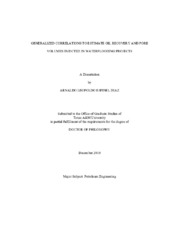| dc.description.abstract | When estimating a waterflood performance and ultimate recovery, practitioners usually prepare a plot of log of water-oil ratio vs. cumulative production or recovery factor and extrapolate the linear section of the curve to a pre-established economic limit of water production. Following this practice, engineers take the risk of overestimating oil production and/or underestimating water production if the economic limit is optimistic. Engineers would be able to avoid that risk if they knew where the linear portion of the curve finishes. We called this linear portion the "straight-line zone" of simply SLZ.
In this research, we studied that ―straight-line zone‖ and determined its boundaries (beginning and end) numerically using mathematics rules. We developed a new procedure and empirical correlations to predict oil recovery factor at any water/oil ratio.
The approach uses the fundamental concepts of fluid displacement under Buckley-Leverett fractional flow theory, reservoir simulation, and statistical analysis from multivariate linear regression.
We used commercial spreadsheet software, the Statistical Analysis Software, a commercial numerical reservoir simulator, and Visual Basic Application software.
We determined generalized correlations to determine the beginning, end, slope, and intercept of this line as a function of rock and fluid properties, such as endpoints of relative permeability curves, connate water saturation, residual oil saturation, mobility ratio, and the Dykstra-Parsons coefficient. Characterizing the SLZ allows us to estimate the corresponding recovery factor and pore volumes injected at any water-oil ratio through the length of the SLZ .
The SLZ is always present in the plot of log of water-oil ratio vs. cumulative production or recovery factor, and its properties can be predicted. Results were correlated in terms of the Dykstra-Parsons coefficient and mobility ratio. Using our correlations, practitioners can estimate the end of the SLZ without the risk of overestimating reserves and underestimating water production. Our procedure is also a helpful tool for forecasting and diagnosing waterfloods when a detailed reservoir simulation model is not available. | en |


